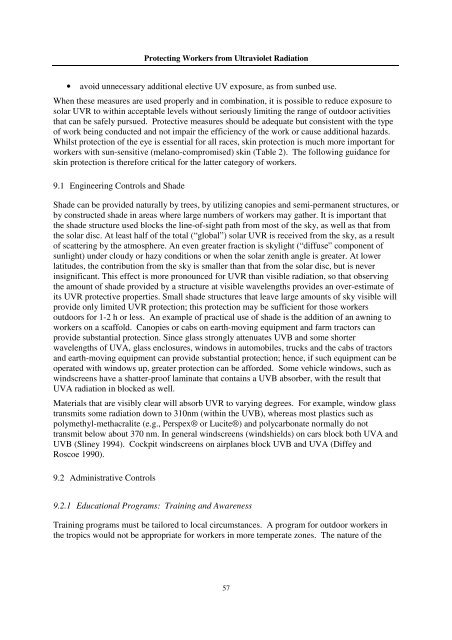Protecting Workers from Ultraviolet Radiation - icnirp
Protecting Workers from Ultraviolet Radiation - icnirp
Protecting Workers from Ultraviolet Radiation - icnirp
You also want an ePaper? Increase the reach of your titles
YUMPU automatically turns print PDFs into web optimized ePapers that Google loves.
<strong>Protecting</strong> <strong>Workers</strong> <strong>from</strong> <strong>Ultraviolet</strong> <strong>Radiation</strong><br />
• avoid unnecessary additional elective UV exposure, as <strong>from</strong> sunbed use.<br />
When these measures are used properly and in combination, it is possible to reduce exposure to<br />
solar UVR to within acceptable levels without seriously limiting the range of outdoor activities<br />
that can be safely pursued. Protective measures should be adequate but consistent with the type<br />
of work being conducted and not impair the efficiency of the work or cause additional hazards.<br />
Whilst protection of the eye is essential for all races, skin protection is much more important for<br />
workers with sun-sensitive (melano-compromised) skin (Table 2). The following guidance for<br />
skin protection is therefore critical for the latter category of workers.<br />
9.1 Engineering Controls and Shade<br />
Shade can be provided naturally by trees, by utilizing canopies and semi-permanent structures, or<br />
by constructed shade in areas where large numbers of workers may gather. It is important that<br />
the shade structure used blocks the line-of-sight path <strong>from</strong> most of the sky, as well as that <strong>from</strong><br />
the solar disc. At least half of the total (“global”) solar UVR is received <strong>from</strong> the sky, as a result<br />
of scattering by the atmosphere. An even greater fraction is skylight (“diffuse” component of<br />
sunlight) under cloudy or hazy conditions or when the solar zenith angle is greater. At lower<br />
latitudes, the contribution <strong>from</strong> the sky is smaller than that <strong>from</strong> the solar disc, but is never<br />
insignificant. This effect is more pronounced for UVR than visible radiation, so that observing<br />
the amount of shade provided by a structure at visible wavelengths provides an over-estimate of<br />
its UVR protective properties. Small shade structures that leave large amounts of sky visible will<br />
provide only limited UVR protection; this protection may be sufficient for those workers<br />
outdoors for 1-2 h or less. An example of practical use of shade is the addition of an awning to<br />
workers on a scaffold. Canopies or cabs on earth-moving equipment and farm tractors can<br />
provide substantial protection. Since glass strongly attenuates UVB and some shorter<br />
wavelengths of UVA, glass enclosures, windows in automobiles, trucks and the cabs of tractors<br />
and earth-moving equipment can provide substantial protection; hence, if such equipment can be<br />
operated with windows up, greater protection can be afforded. Some vehicle windows, such as<br />
windscreens have a shatter-proof laminate that contains a UVB absorber, with the result that<br />
UVA radiation in blocked as well.<br />
Materials that are visibly clear will absorb UVR to varying degrees. For example, window glass<br />
transmits some radiation down to 310nm (within the UVB), whereas most plastics such as<br />
polymethyl-methacralite (e.g., Perspex® or Lucite®) and polycarbonate normally do not<br />
transmit below about 370 nm. In general windscreens (windshields) on cars block both UVA and<br />
UVB (Sliney 1994). Cockpit windscreens on airplanes block UVB and UVA (Diffey and<br />
Roscoe 1990).<br />
9.2 Administrative Controls<br />
9.2.1 Educational Programs: Training and Awareness<br />
Training programs must be tailored to local circumstances. A program for outdoor workers in<br />
the tropics would not be appropriate for workers in more temperate zones. The nature of the<br />
57



